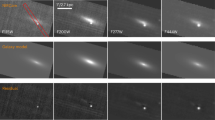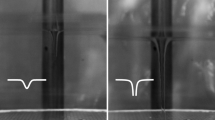Abstract
Roger Penrose proposed that a spatial quantum superposition collapses as a back-reaction from spacetime, which is curved in different ways by each branch of the superposition. In this sense, one speaks of gravity-related wave function collapse. He also provided a heuristic formula to compute the decay time of the superposition—similar to that suggested earlier by Lajos Diósi, hence the name Diósi–Penrose model. The collapse depends on the effective size of the mass density of particles in the superposition, and is random: this randomness shows up as a diffusion of the particles’ motion, resulting, if charged, in the emission of radiation. Here, we compute the radiation emission rate, which is faint but detectable. We then report the results of a dedicated experiment at the Gran Sasso underground laboratory to measure this radiation emission rate. Our result sets a lower bound on the effective size of the mass density of nuclei, which is about three orders of magnitude larger than previous bounds. This rules out the natural parameter-free version of the Diósi–Penrose model.
This is a preview of subscription content, access via your institution
Access options
Access Nature and 54 other Nature Portfolio journals
Get Nature+, our best-value online-access subscription
$29.99 / 30 days
cancel any time
Subscribe to this journal
Receive 12 print issues and online access
$209.00 per year
only $17.42 per issue
Buy this article
- Purchase on Springer Link
- Instant access to full article PDF
Prices may be subject to local taxes which are calculated during checkout





Similar content being viewed by others
Data availability
Source data are provided with this paper. All other data that support the plots within this paper and other findings of this study are available from the corresponding author upon reasonable request.
Code availability
The MC simulation is based on Geant4 code, which is freely accessible at http://geant4.web.cern.ch/support/download. Experimental details used within the simulation code as part of this study are protected by a non-disclosure agreement with the manufacturing company, but the results of the simulation are available for this paper.
References
Schrödinger, E. Die gegenwärtige Situation in der Quantenmechanik. Naturwissenschaften 23, 823–828 (1935).
Leggett, A. J. Macroscopic quantum systems and the quantum theory of measurement. Prog. Theor. Phys. Suppl. 69, 80–100 (1980).
Weinberg, S. Precision tests of quantum mechanics. Phys. Rev. Lett. 62, 485–488 (1989).
Bell, J. S. Speakable and Unspeakable in Quantum Mechanics: Collected Papers on Quantum Philosophy (Cambridge Univ. Press, 2004).
Ghirardi, G. C., Rimini, A. & Weber, T. Unified dynamics for microscopic and macroscopic systems. Phys. Rev. D 34, 470–491 (1986).
Adler, S. L. Quantum Theory as an Emergent Phenomenon: the Statistical Mechanics of Matrix Models as the Precursor of Quantum Field Theory (Cambridge Univ. Press, 2004).
Weinberg, S. Collapse of the state vector. Phys. Rev. A 85, 062116 (2012).
Ghirardi, G. C., Pearle, P. & Rimini, A. Markov processes in Hilbert space and continuous spontaneous localization of systems of identical particles. Phys. Rev. A 42, 78–89 (1990).
Bassi, A. & Ghirardi, G. Dynamical reduction models. Phys. Rep. 379, 257–426 (2003).
Bassi, A., Lochan, K., Satin, S., Singh, T. P. & Ulbricht, H. Models of wave-function collapse, underlying theories, and experimental tests. Rev. Mod. Phys. 85, 471–527 (2013).
Arndt, M. & Hornberger, K. Testing the limits of quantum mechanical superpositions. Nat. Phys. 10, 271–277 (2014).
Feynman, R. Feynman Lectures on Gravitation (CRC Press, 2018).
Penrose, R. & Mermin, N. D. The Emperor’s New Mind: Concerning Computers, Minds, and the Laws of Physics (Oxford Univ. Press, 1990).
Penrose, R. On gravity’s role in quantum state reduction. Gen. Relativ. Gravit. 28, 581–600 (1996).
Penrose, R. On the gravitization of quantum mechanics 1: Quantum state reduction. Found. Phys. 44, 557–575 (2014).
Howl, R., Penrose, R. & Fuentes, I. Exploring the unification of quantum theory and general relativity with a Bose–Einstein condensate. New J. Phys. 21, 043047 (2019).
Diósi, L. A universal master equation for the gravitational violation of quantum mechanics. Phys. Lett. A 120, 377–381 (1987).
Diósi, L. Models for universal reduction of macroscopic quantum fluctuations. Phys. Rev. A 40, 1165–1174 (1989).
Ghirardi, G., Grassi, R. & Rimini, A. Continuous-spontaneous-reduction model involving gravity. Phys. Rev. A 42, 1057–1064 (1990).
Diósi, L. Gravity-related wave function collapse: mass density resolution. J. Phys. Conf. Ser. 442, 012001 (2013).
Diósi, L. Gravitation and quantum-mechanical localization of macro-objects. Phys. Lett. A 105, 199–202 (1984).
Bahrami, M., Großardt, A., Donadi, S. & Bassi, A. The Schrödinger–Newton equation and its foundations. New J. Phys. 16, 115007 (2014).
Salart, D., Baas, A., van Houwelingen, J. A., Gisin, N. & Zbinden, H. Spacelike separation in a Bell test assuming gravitationally induced collapses. Phys. Rev. Lett. 100, 220404 (2008).
Marshall, W., Simon, C., Penrose, R. & Bouwmeester, D. Towards quantum superpositions of a mirror. Phys. Rev. Lett. 91, 130401 (2003).
Kovachy, T. et al. Quantum superposition at the half-metre scale. Nature 528, 530–533 (2015).
Fein, Y. Y. et al. Quantum superposition of molecules beyond 25 kDa. Nat. Phys. 15, 1242–1245 (2019).
Lee, K. C. et al. Entangling macroscopic diamonds at room temperature. Science 334, 1253–1256 (2011).
Chan, J. et al. Laser cooling of a nanomechanical oscillator into its quantum ground state. Nature 478, 89–92 (2011).
Teufel, J. et al. Sideband cooling of micromechanical motion to the quantum ground state. Nature 475, 359–363 (2011).
Wollman, E. E. et al. Quantum squeezing of motion in a mechanical resonator. Science 349, 952–955 (2015).
Jain, V. et al. Direct measurement of photon recoil from a levitated nanoparticle. Phys. Rev. Lett. 116, 243601 (2016).
Hong, S. et al. Hanbury Brown and Twiss interferometry of single phonons from an optomechanical resonator. Science 358, 203–206 (2017).
Vovrosh, J. et al. Parametric feedback cooling of levitated optomechanics in a parabolic mirror trap. J. Opt. Soc. Am. B 34, 1421–1428 (2017).
Riedinger, R. et al. Remote quantum entanglement between two micromechanical oscillators. Nature 556, 473–477 (2018).
Bahrami, M., Smirne, A. & Bassi, A. Role of gravity in the collapse of a wave function: a probe into the Diósi–Penrose model. Phys. Rev. A 90, 062105 (2014).
Helou, B., Slagmolen, B., McClelland, D. E. & Chen, Y. LISA Pathfinder appreciably constrains collapse models. Phys. Rev. D 95, 084054 (2017).
Diósi, L. & Lukács, B. Calculation of X-ray signals from Károlyházy hazy space-time. Phys. Lett. A 181, 366–368 (1993).
Neder, H., Heusser, G. & Laubenstein, M. Low level γ-ray germanium-spectrometer to measure very low primordial radionuclide concentrations. Appl. Radiat. Isot. 53, 191–195 (2000).
Heusser, G., Laubenstein, M. & Neder, H. Low-level germanium gamma-ray spectrometry at the μBq/kg level and future developments towards higher sensitivity. Radioact. Environ. 8, 495–510 (2006).
Fu, Q. Spontaneous radiation of free electrons in a nonrelativistic collapse model. Phys. Rev. A 56, 1806–1811 (1997).
Piscicchia, K. et al. CSL collapse model mapped with the spontaneous radiation. Entropy 19, 319 (2017).
Tilloy, A. & Stace, T. M. Neutron star heating constraints on wave-function collapse models. Phys. Rev. Lett. 123, 080402 (2019).
Debye, P. Interferenz von Röntgenstrahlen und Wärmebewegung. Ann. Phys. 348, 49–92 (1913).
Waller, I. Zur Frage der Einwirkung der Wärmebewegung auf die Interferenz von Röntgenstrahlen. Z. Phys. 17, 398–408 (1923).
Gao, H. & Peng, L.-M. Parameterization of the temperature dependence of the Debye–Waller factors. Acta Crystallogr. A 55, 926–932 (1999).
Adler, S. L. & Bassi, A. Collapse models with non-white noises. J. Phys. A 40, 15083 (2007).
Adler, S. L. & Bassi, A. Collapse models with non-white noises: II. Particle-density coupled noises. J. Phys. A 41, 395308 (2008).
Gasbarri, G., Toroš, M., Donadi, S. & Bassi, A. Gravity induced wave function collapse. Phys. Rev. D 96, 104013 (2017).
Breuer, H. P. & Petruccione, F. The Theory of Open Quantum Systems (Oxford Univ. Press, 2002).
Adler, S. L. & Ramazanoglu, F. M. Photon-emission rate from atomic systems in the CSL model. J. Phys. A 40, 13395 (2007).
Adler, S. L., Bassi, A. & Donadi, S. On spontaneous photon emission in collapse models. J. Phys. A 46, 245304 (2013).
Bassi, A. & Donadi, S. Spontaneous photon emission from a non-relativistic free charged particle in collapse models: a case study. Phys. Lett. A 378, 761–765 (2014).
Donadi, S., Deckert, D.-A. & Bassi, A. On the spontaneous emission of electromagnetic radiation in the CSL model. Ann. Phys. 340, 70–86 (2014).
Boswell, M. et al. Mage—a Geant4-based Monte Carlo application framework for low-background germanium experiments. IEEE Trans. Nucl. Sci. 58, 1212–1220 (2011).
Acknowledgements
We thank S. L. Adler, M. Arndt and H. Ulbricht for useful discussions and comments, and C. Capoccia, M. Carlesso and R. Del Grande for their help in preparing the figures. S.D. acknowledges support from The Foundation BLANCEFLOR Boncompagni Ludovisi, née Bildt, INFN and the Fetzer Franklin Fund. K.P. and C.C. acknowledge the support of the Centro Fermi—Museo Storico della Fisica e Centro Studi e Ricerche ‘Enrico Fermi’ (Open Problems in Quantum Mechanics project), the John Templeton Foundation (ID 58158) and FQXi. L.D. acknowledges the support of the National Research Development and Innovation Office of Hungary, grant nos. 2017-1.2.1-NKP-2017-00001 and K12435, and support by an FQXi minigrant. A.B. acknowledges support from the H2020 FET TEQ (grant no. 766900), the University of Trieste and INFN. All authors acknowledge support from the COST Action QTSpace (grant no. CA15220).
Author information
Authors and Affiliations
Contributions
S.D. and A.B. conceived and designed the theoretical aspects of the research; M.L., K.P. and C.C. designed the experimental part of the research; S.D. performed the theoretical calculations, with the assistance of A.B. and L.D.; M.L., K.P. and C.C. performed the experimental measurements; K.P. performed the data analysis, with the assistance of C.C., M.L. and L.D.; S.D., K.P. and A.B. prepared the manuscript and Supplementary Information in coordination with all authors.
Corresponding authors
Ethics declarations
Competing interests
The authors declare no competing interests.
Additional information
Publisher’s note Springer Nature remains neutral with regard to jurisdictional claims in published maps and institutional affiliations.
Supplementary information
Supplementary Information
Full theoretical and experimental analysis; Supplementary Figs. 1 and 2.
Source data
Source Data Fig. 3
Source Data for Fig. 3.
Source Data Fig. 4
Source Data for Fig. 4.
Rights and permissions
About this article
Cite this article
Donadi, S., Piscicchia, K., Curceanu, C. et al. Underground test of gravity-related wave function collapse. Nat. Phys. 17, 74–78 (2021). https://doi.org/10.1038/s41567-020-1008-4
Received:
Accepted:
Published:
Issue Date:
DOI: https://doi.org/10.1038/s41567-020-1008-4
This article is cited by
-
Search for decoherence from quantum gravity with atmospheric neutrinos
Nature Physics (2024)
-
Gravitationally induced decoherence vs space-time diffusion: testing the quantum nature of gravity
Nature Communications (2023)
-
Conformal Cyclic Cosmology, gravitational entropy and quantum information
General Relativity and Gravitation (2023)
-
Lindbladian-Induced Alignment in Quantum Measurements
Foundations of Physics (2023)
-
The weak field limit of quantum matter back-reacting on classical spacetime
Journal of High Energy Physics (2023)



